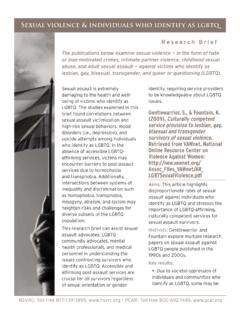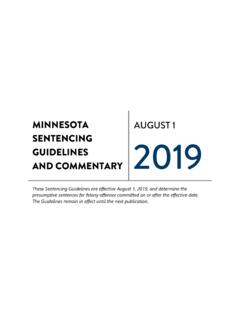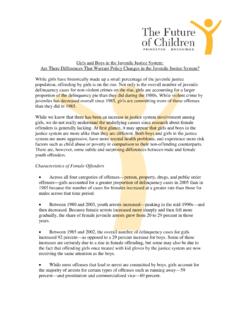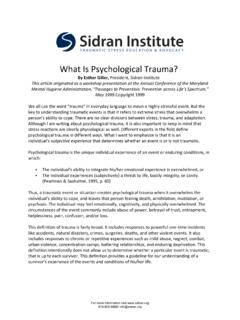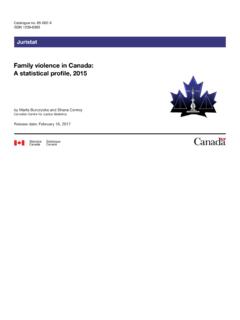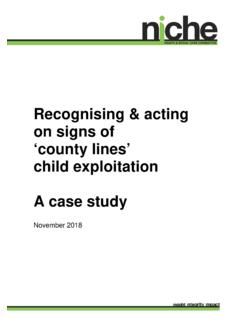Transcription of Preventing Child Sexual Abuse Within Youth-serving ...
1 PreventingChild Sexual Abuse Within Youth-serving Organizations:Getting Started on Policies and ProceduresFor more information:Centers for Disease Control and PreventionNational Center for Injury Prevention and Control1-800-CDC-INFO DEPARTMENT OF HEALTH AND HUMAN SERVICESC enters for Disease Control and Prevention CS107800 Preventing Child Sexual Abuse Within Youth-serving Organizations: Getting Started on Policies and DEPARTMENT OF HEALTH AND HUMAN SERVICESC enters for Disease Control and Prevention National Center for Injury Prevention and Control Division of Violence PreventionAtlanta, Georgia2007iiPreventing Child Sexual Abuse Within Youth-serving Organizations: Getting Started on Policies and Procedures is a publication of the National Center for Injury Prevention and Control of the Cen-ters for Disease Control and for Disease Control and PreventionJulie L.
2 Gerberding, , , DirectorCoordinating Center for Environmental Health and Injury PreventionHenry Falk, , , DirectorNational Center for Injury Prevention and ControlIleana Arias, , DirectorDivision of Violence PreventionW. Rodney Hammond, , DirectorSuggested citation: Saul J, Audage NC. Preventing Child Sexual Abuse Within Youth-serving Organizations: Getting Started on Policies and Procedures. Atlanta (GA): Centers for Disease Control and Prevention, National Center for Injury Prevention and Control; Saul, of Violence PreventionNational Center for Injury Prevention and ControlNatalie C.
3 Audage, and former ASPH/CDC FellowAcknowledgementsThe authors would like to acknowledge the individuals and organizations that participated in the meeting of experts sponsored by CDC in August 2004. The authors would also like to thank Kristin Leydig Bryant for facilitating the meeting and Deborah A. Ausburn, Attorney at Law, for reviewing the document. ivTable of ContentsIntroduction ..1 Components of Child Sexual Abuse Prevention ..3 Screening and selecting employees and volunteers ..4 Guidelines on interactions between individuals.
4 9 Monitoring safe environments ..15 Responding to inappropriate behavior, breaches in policy, and allegations and suspicions of Child Sexual Abuse ..17 Training about Child Sexual Abuse prevention ..22 Training employees/volunteers ..24 Training caregivers ..27 Training youth ..28 Overcoming Challenges to Child Sexual Abuse Prevention in Youth-serving Organizations ..29 Conclusion: Moving Forward ..33 Organizational processes for developing and implementing Child Sexual Abuse prevention policies ..33 Child Sexual Abuse prevention planning tool for A: Participant List.
5 39 Appendix B: Resource List and Sample Policies ..42 Books/Publications/Videos/Workshops ..42 Journal articles ..47 Sample policies from participating organizations ..47 Publications with sample policies and procedures ..48 Relevant organizations ..49 IntroductionYouth-serving organizations strive to create a safe environment for youth, employees, and volunteers so that youth can grow, learn, and have fun. Part of creating a safe environment is making sure that youth are not harmed in any way while participating in organization-sponsored activities.
6 One risk in any organization working directly with youth is Child Sexual Abuse . It is vital that organizations create a culture where Child Sexual Abuse is discussed, addressed, and prevented. This report is designed for representatives of Youth-serving organizations who are interested in adopting strategies to prevent Child Sexual Abuse . Whether these strategies are developed Within the context of an overall risk management plan or are addressed separately, organizations need to examine how they can protect youth from Sexual Abuse .
7 Definitions Children and youth- Anyone between the ages of zero and 17 years. In this document, these terms are used interchangeably. Child Sexual Abuse - Child Sexual Abuse involves any Sexual activity with a Child where consent is not or can-not be given. This includes Sexual contact that is accomplished by force or threat of force, regardless of the age of the participants, and all Sexual contact between an adult and a Child , regardless of whether there is deception or the Child understands the Sexual nature of the activity.
8 Sexual contact between an older and a younger Child also can be abusive if there is a significant disparity in age, development, or size, rendering the younger Child incapable of giving informed consent. The sexually abusive acts may include Sexual penetration, Sexual touching, or non-contact Sexual acts such as exposure or voyeurism. 1 - Legal definitions vary by state, so look up your state guidelines using the Child Welfare Information Gateway ( ). What You Will Find in This ReportIn the first section, you will find six key components of Child Sexual Abuse prevention for organi-zations.
9 These components were identified by the Centers for Disease Control and Prevention (CDC) in conjunction with experts: 1. Screening and selecting employees and volunteers2. Guidelines on interactions between individuals3. Monitoring behavior4. Ensuring safe environments5. Responding to inappropriate behavior, breaches in policy, and allegations and suspicions of Child Sexual abuse6. Training about Child Sexual Abuse JEB, Berliner L, Briere J, Hendrix CT, Jenny C, Reid TA, editors. The APSAC handbook of Child maltreatment.
10 2nd ed. Thousand Oaks (CA): Sage Publications; 2002. p. 55. Each component is described in detail, including the prevention goals, critical strategies, and ad-ditional strategies that could be considered depending on the context and resources of individual organizations. The sections that follow offer suggestions for addressing challenges to developing and implement-ing a strategy to prevent Child Sexual Abuse and provide tools to help organizations move forward. A list of publications and organizations that can provide helpful information is provided in Appendix B.










